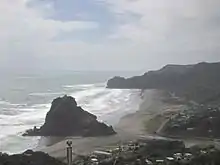 | |
| Geography | |
| Location | Auckland, New Zealand |
| Coordinates | 36°57′13″S 174°27′58″E / 36.95368°S 174.46602°E |
| Adjacent to | Tasman Sea |
| Highest elevation | 52 m (171 ft) |
| Administration | |
New Zealand | |
Lion Rock is a rocky headland located on Piha Beach in the Waitākere Ranges area of the Auckland Region, New Zealand.
Geography
The rock is located to the south of Piha beach, close to the major settlement at Piha. The Piha Stream flows into the Tasman Sea directly south of the rock.[1]
Geology
_(AM_PH-NEG-2504).jpg.webp)

The island is a volcanic plug of the Miocene era Waitākere Volcano, composed of stratified rudite and intrusive andesite.[2] The rock is what remains of one of the volcano's funnel-shaped vents on the eastern side of the mountain, which was uplifted from the sea 17 million years ago.[3] As the volcano aged and eroded, the Lion Rock vent filled with collapsed lava, scoria and volcanic bombs, until it formed into its modern-day shape.[4]
History
The traditional name for the rock is Te Piha, and is a name that was applied to the wider area.[5] The name Te Piha came from the pattern made when waves hit against the rock.[6] Lion Rock is in the rohe of Te Kawerau ā Maki, and was the location of island pā known as Whakaari,[7] which literally means "exposed to view" or "display".[8] The pā was captured by a Ngāti Whātua war party led by Tainui warrior Kāwharu around the year 1700.[7]
Archaeological surveys have shown the remains of platforms, midden and terraces on Lion Rock, as well as fragments of traditional textiles, dating back to a time before European contact.[9] The earthworks of Whakaari pā are not well preserved due to erosion.[10]
References
- ↑ "Piha Stream". New Zealand Gazetteer. Land Information New Zealand. Retrieved 30 June 2022.
- ↑ Hayward, B. W. (1977). "Miocene volcanic centres of the Waitakere Ranges, North Auckland, New Zealand". Journal of the Royal Society of New Zealand. 7 (2): 123–141. doi:10.1080/03036758.1977.10427155.
- ↑ Hayward, Bruce (2009). "Land, Sea and Sky". In Macdonald, Finlay; Kerr, Ruth (eds.). West: The History of Waitakere. Random House. p. 10. ISBN 9781869790080.
- ↑ Hayward, Bruce W. (2017). Out of the Ocean, Into the Fire. Geoscience Society of New Zealand. pp. 116–117. ISBN 978-0-473-39596-4.
- ↑ Te Kawerau ā Maki; The Trustees of Te Kawerau Iwi Settlement Trust; The Crown (22 February 2014). "Te Kawerau ā Maki Deed of Settlement Schedule" (PDF). Retrieved 10 May 2022.
- ↑ Cameron, Ewen; Hayward, Bruce; Murdoch, Graeme (2008). A Field Guide to Auckland: Exploring the Region's Natural and Historical Heritage (Revised ed.). Random House New Zealand. p. 174. ISBN 978-1-86962-1513.
- 1 2 Diamond, John T.; Hayward, Bruce W. (1979). The Māori history and legends of the Waitākere Ranges. The Lodestar Press. p. 4. ISBN 9781877431210.
- ↑ "Lion Rock". New Zealand Gazetteer. Land Information New Zealand. Retrieved 30 June 2022.
- ↑ McKendry, Lisa (2017). "Māori Kākahu (Cloak) Fragments from Piha: Whakaari Pā". Records of the Auckland Museum. 52: 59–70. doi:10.32912/ram.2017.52.4.
- ↑ Diamond, John T.; Hayward, Bruce W. (1990). "Prehistoric Sites in West Auckland". In Northcote-Bade, James (ed.). West Auckland Remembers, Volume 1. West Auckland Historical Society. pp. 33–34, 36. ISBN 0-473-00983-8.